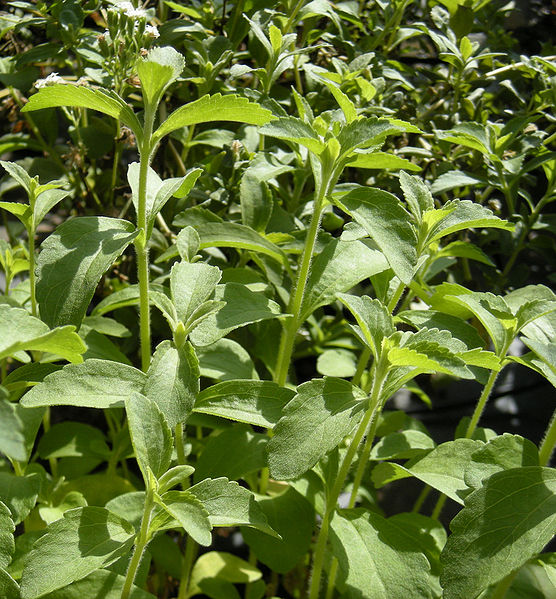Stevia (Stevia rebaudiana) is a perennial herb native to the tropical and sub-tropical areas of South America and Western North America. Also called “sweetleaf”, the leaves are 40 times as sweet as sugar. Dieters and diabetics like to substitute stevia for sugar because it has no calories and is not metabolized by the body.
Stevia leaves can be used fresh or dried to sweeten drinks. You can dry the leaves to substitute for sugar when baking. Use 1/8 teaspoon of dried leaves for each 1 teaspoon of sugar. Bear in mind that dried stevia leaves do not caramelize like sugar and they cannot feed yeast in breads and rolls.
Traditionally, stevia was used to flavor medicinal teas in Brazil and Paraguay.
Stevia is hardy in zones 9 – 11. The plants can survive winters with protection in zone 8. Those of us in northern areas grow it as an annual or bring it indoors during the winter. The plants need well drained soil and full sun. Keep them well watered. The roots are shallow and dry out easily. Mature plants reach a height of 18 to 24 inches tall depending on how warm your summers are. If you pinch your plant to encourage branching, it can grow to 24 inches wide.
Stevia flowers are small and white, appearing in late summer. The leaves are sweetest before the plants bloom so deadhead your plants (remove the flower buds) to keep them producing sweet leaves.
Harvest can begin in mid-summer and last through the fall. Be sure to harvest in the early morning before the dew dries for the sweetest leaves. Cut the plants down before the first frost and dry them for use during the winter. Alternatively, you can grow your plants in containers and bring them indoors during the winter so that you can continue to harvest fresh leaves.
Stevia is difficult to grow from seed. The germination rate is very low. Most people purchase plants in the spring. Stevia roots easily from cuttings so if you bought 1 or 2 plants, you could take cuttings from the branch tips to grow more plants. In the fall, instead of harvesting and drying the entire plant, you could take cuttings so that you will have a supply of fresh leaves all winter. Simply dip your cuttings into rooting hormone and press into the soil. Roots should start growing in 2 to 3 weeks. You will know that roots are growing when you see new leaves on your cuttings.

